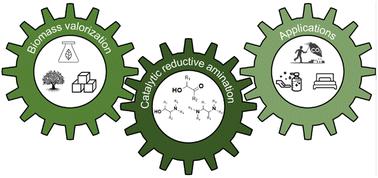当前位置:
X-MOL 学术
›
Chem. Soc. Rev.
›
论文详情
Our official English website, www.x-mol.net, welcomes your
feedback! (Note: you will need to create a separate account there.)
From sugars to aliphatic amines: as sweet as it sounds? Production and applications of bio-based aliphatic amines
Chemical Society Reviews ( IF 40.4 ) Pub Date : 2024-10-04 , DOI: 10.1039/d4cs00244j Benjamin Vermeeren, Sofie Van Praet, Wouter Arts, Thomas Narmon, Yingtuan Zhang, Cheng Zhou, Hans P. Steenackers, Bert F. Sels
Chemical Society Reviews ( IF 40.4 ) Pub Date : 2024-10-04 , DOI: 10.1039/d4cs00244j Benjamin Vermeeren, Sofie Van Praet, Wouter Arts, Thomas Narmon, Yingtuan Zhang, Cheng Zhou, Hans P. Steenackers, Bert F. Sels

|
Aliphatic amines encompass a diverse group of amines that include alkylamines, alkyl polyamines, alkanolamines and aliphatic heterocyclic amines. Their structural diversity and distinctive characteristics position them as indispensable components across multiple industrial domains, ranging from chemistry and technology to agriculture and medicine. Currently, the industrial production of aliphatic amines is facing pressing sustainability, health and safety issues which all arise due to the strong dependency on fossil feedstock. Interestingly, these issues can be fundamentally resolved by shifting toward biomass as the feedstock. In this regard, cellulose and hemicellulose, the carbohydrate fraction of lignocellulose, emerge as promising feedstock for the production of aliphatic amines as they are available in abundance, safe to use and their aliphatic backbone is susceptible to chemical transformations. Consequently, the academic interest in bio-based aliphatic amines via the catalytic reductive amination of (hemi)cellulose-derived substrates has systematically increased over the past years. From an industrial perspective, however, the production of bio-based aliphatic amines will only be the middle part of a larger, ideally circular, value chain. This value chain additionally includes, as the first part, the refinery of the biomass feedstock to suitable substrates and, as the final part, the implementation of these aliphatic amines in various applications. Each part of the bio-based aliphatic amine value chain will be covered in this Review. Applying a holistic perspective enables one to acknowledge the requirements and limitations of each part and to efficiently spot and potentially bridge knowledge gaps between the different parts.
中文翻译:

从糖到脂肪胺:听起来很甜?生物基脂肪胺的生产和应用
脂肪胺包括一组不同的胺,包括烷基胺、烷基多胺、烷醇胺和脂肪族杂环胺。它们的结构多样性和独特特性使它们成为从化学和技术到农业和医学等多个工业领域不可或缺的组成部分。目前,脂肪胺的工业生产面临着紧迫的可持续性、健康和安全问题,这些问题都是由于对化石原料的强烈依赖而出现的。有趣的是,这些问题可以通过转向生物质作为原料来从根本上解决。在这方面,纤维素和半纤维素(木质纤维素的碳水化合物部分)成为生产脂肪胺的有前途的原料,因为它们含量丰富、使用安全,并且它们的脂肪族主链容易受到化学转化的影响。因此,在过去几年中,学术界对通过(半)纤维素衍生底物的催化还原胺化作用制备生物基脂肪胺的兴趣系统性地增加。然而,从工业角度来看,生物基脂肪胺的生产只是更大、最好是循环价值链的中间部分。该价值链还包括作为第一部分,将生物质原料精炼成合适的基材,最后部分,这些脂肪胺在各种应用中的实施。本综述将涵盖生物基脂肪胺价值链的每个部分。应用整体视角使人们能够认识到每个部分的要求和局限性,并有效地发现并可能弥合不同部分之间的知识差距。
更新日期:2024-10-05
中文翻译:

从糖到脂肪胺:听起来很甜?生物基脂肪胺的生产和应用
脂肪胺包括一组不同的胺,包括烷基胺、烷基多胺、烷醇胺和脂肪族杂环胺。它们的结构多样性和独特特性使它们成为从化学和技术到农业和医学等多个工业领域不可或缺的组成部分。目前,脂肪胺的工业生产面临着紧迫的可持续性、健康和安全问题,这些问题都是由于对化石原料的强烈依赖而出现的。有趣的是,这些问题可以通过转向生物质作为原料来从根本上解决。在这方面,纤维素和半纤维素(木质纤维素的碳水化合物部分)成为生产脂肪胺的有前途的原料,因为它们含量丰富、使用安全,并且它们的脂肪族主链容易受到化学转化的影响。因此,在过去几年中,学术界对通过(半)纤维素衍生底物的催化还原胺化作用制备生物基脂肪胺的兴趣系统性地增加。然而,从工业角度来看,生物基脂肪胺的生产只是更大、最好是循环价值链的中间部分。该价值链还包括作为第一部分,将生物质原料精炼成合适的基材,最后部分,这些脂肪胺在各种应用中的实施。本综述将涵盖生物基脂肪胺价值链的每个部分。应用整体视角使人们能够认识到每个部分的要求和局限性,并有效地发现并可能弥合不同部分之间的知识差距。


















































 京公网安备 11010802027423号
京公网安备 11010802027423号